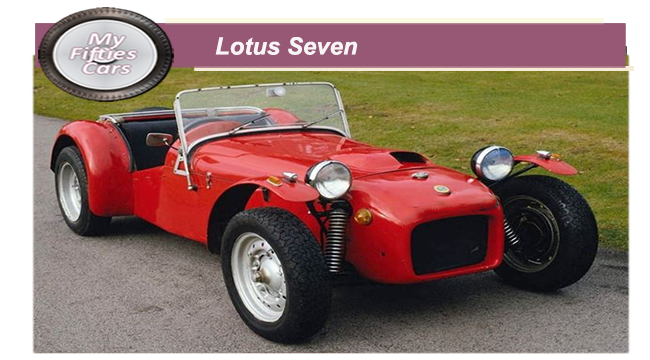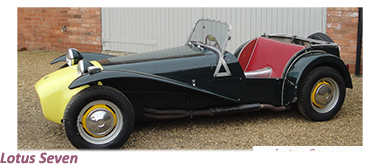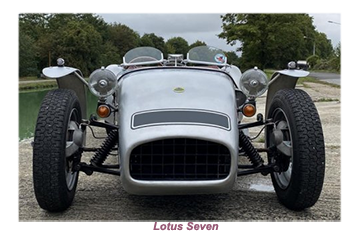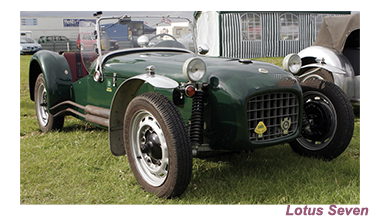
Very few of the people who grew up during the Fifties who set their eyes on the Lotus Seven could possibly have imagined that the car would go on to become an icon of the motor industry for more than three decades.
 The Lotus Seven of legend first appeared in kit form, an innovation was nothing less than a stroke of minimalist genius, using readily available parts that would fit into the radical geometry of its lightweight, tubular and steel panel frame.
The Lotus Seven of legend first appeared in kit form, an innovation was nothing less than a stroke of minimalist genius, using readily available parts that would fit into the radical geometry of its lightweight, tubular and steel panel frame.
In addition, Lotus owner Colin Chapman, never slow at trying to one over on the “establishment” discovered that according to the British tax laws in 1957, it was possible to get away with paying Sales Tax (then known as Purchase Tax) on any car sold in kit form.
 The only condition was that the vehicle did not come with any assembly instructions.
The only condition was that the vehicle did not come with any assembly instructions.
 What Lotus did provide Seven buyers was a detailed explanation of how to unassembled the Seven, which, off the record, were the assembly instructions to be followed entirely in reverse.
What Lotus did provide Seven buyers was a detailed explanation of how to unassembled the Seven, which, off the record, were the assembly instructions to be followed entirely in reverse.
This was a classic example of the typical lateral thinking that drove Chapman and Lotus forward and made their cars, in particular, the Lotus Seven, so appealing to the diverse cross-section of the motoring public.
![]()
Lotus, run by the talented Colin Chapman, introduced the first Lotus Seven in the late Fifties, providing it with three significant updates before selling the production rights passed to Caterham Cars in 1973.
 To their credit, Caterham has done very little to change the character of the Seven, and the model is still in production to this day.
To their credit, Caterham has done very little to change the character of the Seven, and the model is still in production to this day.
 The original Seven's power came from a Ford engine, either from the 1172cc (72 cu in) de-valve unit or the Consul engine, reduced in capacity to qualify for the 1500cc (92 cu in) competition category.
The original Seven's power came from a Ford engine, either from the 1172cc (72 cu in) de-valve unit or the Consul engine, reduced in capacity to qualify for the 1500cc (92 cu in) competition category.
Anyone optimistic enough to look for a luxurious life from the Seven soon had their eyes opened. There were virtually no creature comforts, with early versions not even having the luxury of opening doors.
 The cockpit itself was narrow and cramped, and could not accommodate anyone above average height, with the hood on.
The cockpit itself was narrow and cramped, and could not accommodate anyone above average height, with the hood on.
Even those that did fit had to adopt the notorious 'elbows-out' driving position. Two cushions — one on the floor, the other on the back panel — were all the driver and passenger had in terms of seating.
![]()
 On entry models, the canvas hood and windscreen wipers were listed as extras a fuel gauge was not even fitted as standard until the S3 version arrived in 1968.
On entry models, the canvas hood and windscreen wipers were listed as extras a fuel gauge was not even fitted as standard until the S3 version arrived in 1968.
As you could be expected, luggage space on the Seven was severely limited, with the boot just big enough to store the fabric hood and side screens.
Like traditional 1930s sports cars, the spare wheel was mounted externally on the boot lid.
 The early versions of the Lotus Seven were so spartan that it was often lovingly described by a member of the motoring media as `like driving a motorised roller-skate'.
The early versions of the Lotus Seven were so spartan that it was often lovingly described by a member of the motoring media as `like driving a motorised roller-skate'.
What the Seven did offer was an excellent power-to-weight ratio, low ride height and staggering road-holding abilities and most importantly pure “seat-of-the-pants” motoring.


